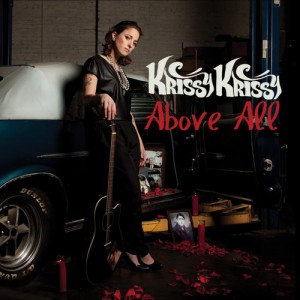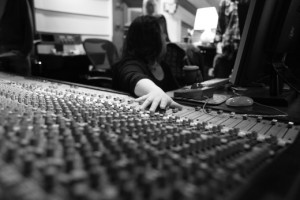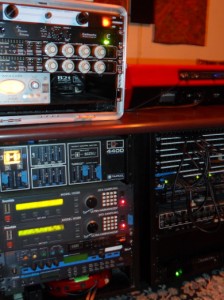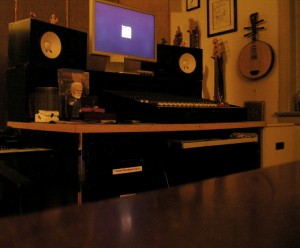Mix Analysis: “Broken Glass” by Krissy Krissy – Mixed by Denise Barbarita
Mixer: Denise Barbarita, http://www.Myshytune.com
The Mix Facility: MyShyTune Studio, Forest Hills, NY (Queens)
Artist and Song: Krissy Krissy, “Broken Glass”
Streaming Link:
Construction materials: The genre is acoustic pop, live drums, bass, acoustic guitar, spattering of percussion, some organ, female lead vocal, female BGV. Not too many of them, unprocessed thankfully. All in all, about 35-40 tracks all together.
Of the 4 songs that I mixed for her debut EP “Above All”, three of them I got on the first try.
“Broken Glass” was NOT one of those 3.
“Broken Glass” was the second track I received. Whenever I get tracks and open them for the first time, I just hit “play.” In this case, there was a lot of internal bussing going on and I guess the ruffs were mixed in the box, and then bounced out because the master mix was also internally bussed.
All four of the tracks came to me with a gazillion plugins, submixes that went to submixes that went to master submixes that went to a final master bus. I got rid of all of that and started from scratch.
Once I got rid of all of the extraneous bussing, I immediately liked the song . Super catchy, good vocal performance, I like the lyric a lot and it’s a positive message. All great things! However, I wasn’t sold on the guitars. The main acoustic guitar being the main culprit.
This song was also very different from the first track I mixed, so we had a pow wow, and I asked for a few references to get an idea of what they were looking for. The references I got were Santana and Melissa Etheridge.
Strange combo, but I figured acoustic pop with some Latin elements, right? I mentioned my issue with the acoustic guitar and they gave me carte blanche to go ahead and do what I thought was good. I suggested adding a little percussion for extra Latin flair, and re-tracking the main acoustic guitar part as well as the solo guitar part.
As it turns out, my writing partner Kelsey Warren pILLOW tHEORY came over that day.
He came by as I was about to re-track the acoustic guitar and offered to lend a hand. We added the new acoustic guitar, and did some Santana/John Mayer-ish guitar leads, some rhythm parts, and my husband Rich Kulsar added some Latin percussion. Before I went ahead and mixed the track, I sent a ruff, along with my Santana reference track (“Game of Love”).
The verdict? “A for effort but not quite what we had in mind. But, you know? This could be a great AAA re-mix version.”

Krissy Krissy’s debut EP, “Above All,” including the soulfully addictive “Broken Glass”, just launched.
Epic fail. LOL
Then the conversation took a turn:
Client: Where are the Bachata guitars?
Me: What Bachata guitars?
Client: They should be there!
Me: I didn’t see anything, there was some solo guitar thing but I’m not sure it’s useable, so we replaced it.
Client: Oh, maybe the producer sent you the wrong version.
Me: Do you have a ruff I can use as a reference?
An hour later:
Client: The producer is on the way to Japan, How about you start on the ballad and I’ll see if I have the tracks somewhere else.
OK
The next day, they sent me a ruff mix. A well-loved rough mix. OK! There’s that solo guitar prominently in the mix. THAT was the “bachata guitar”. Got it. No problem.
So, of the overdubs we did, I kept a shaker, a wood block in the chorus, and the new main acoustic guitar. Mixed the tune, sticking close to the ruff. Sent it for approval. There was hesitation as it didn’t sound like the ruff mix, it had all of the correct elements, just it wasn’t “raw”.
OK
Since the ballad was already done, I suggested they play all three mixes back to back along with the other two they had completed previously elsewhere. Listen to the mix in context, rather than solely comparing it to the ruff. Once heard in context, everyone loved it.
Mixing It! More About the Process
Again, whenever I get a Pro Tools file, I open it and hit play.
While it’s playing I take a look at the tracks, see what’s there. Listen to it a couple times, name tracks while I’m at it, move things around to my liking.
I listen a few times, get the song in my head. I start to isolate individual tracks if anything sticks out. 99% of the time, I nix whatever plug-ins are there already. If the plug-in is shaping the sound, i.e. it’s a re-amp on a guitar, I tend to leave it for later.
I know a lot of mixers who have a Mix template all set up with their plug ins ready to go. I don’t do that. I don’t want to look at anything I’m not using. Besides, I still don’t know exactly what I’m going to use yet, I let the song and the individual elements dictate that. Yes, I have some tried and trues, for sure, but rather than approaching a mix based on having to use the gear that’s at my disposal, I listen to the track a few times, listen to individual elements, then decide what needs help and what KIND of help.
It’s easy to just start slapping plugins on tracks, but I’m a “less is more” type when it comes to mixing. Having 300 plugins is great, you don’t need to use them all at once and if you always have a mix template you tend to do use the same bag of tricks every time. I tend to ask the question, “Why doesn’t this work” or “How do I make this fit”? Search through the sea of plugins and experiment a little on problematic elements.
Vocals, Drums, Guitars, Keys
When I’m mixing tracks with vocals, I ALWAYS start with the vocals. Get the voice sounding exactly as I want it, give it some shimmer and some shape. Get the reverb right.
Then once I get the vocal where I want it, I add the BGV, get those sounding good with the lead vocal, do whatever editing needs to be done, then add the kick. If I hate the kick drum I may trigger it with something else. Blend the original with a trigger.
Usually that’s the case. I have a folder of kick drum samples I’ve created or tracked that I use for these occasions…
Drumagog makes that a breeze. Once I’m happy with that balance, I add the snare. If the vocal sounds different suddenly, I know I have to mess with the snare. Again, that may involve a quick EQ or I may trigger it, or both. Then on to the bass, same story: Nine times out of ten I’ll use one of my Distressors for the bass. Maybe EQ it slightly, if needed. Sometimes I may have to re-visit the kick drum again once the bass is to my liking.
It’s a balancing act. The vocal needs to be at the forefront and always the shining beacon. Everything gets molded around that.
Next, if there are guitars or keys, that’s when I add them. Usually that’s when the scheisse hits the fan, especially in tracks with female vocals. Once, I get those relationships figured out, my gain staging is a bit of a mess, and I mute everything and start with the vocal again, add the drums, get my levels, add the other elements one by one, start rides and fades and that type of thing.
The biggest challenge of this mix was getting the “bachata guitars” to fit. The parts tend to play along with the vocal and they sit in the same range so they fight for attention. We had a few fights, me and that guitar, yelling screaming gnashing of teeth. It was ugly, but finally we were able to find a compromise. LOL
I think I wound up squashing that guitar within an inch of its life, cutting it out in some places and added a thick spring. Actually, the “voice doubler” patch on the Eventide, which I generally reserve for vocals, came to the rescue.
My secret weapon lately is the Waves CLA vocal plug in. LOVE it. I don’t remember how I found out about it. Might have been at another studio? Regardless, I tried it once and decided I had to have it.
Buuuut, 60% of the time, it’s perfect, stunning even! Sometimes I use the reverb and compression settings, sometimes I use it only for the EQ, depends really. 40% of the time, it’s just wrong. LOL but isn’t that the way it is with most things?
For this song it was the wrong choice. It didn’t flatter Krissy’s voice, it just made it husky.. Not brittle, not shrill, just…not RIGHT! So, I tried a few combinations, nothing made me happy until I went to my other favorite, which is the Slightly Rude Compressor.
And voila! Perfection. I also added the URS Full Tech EQ. I like that one a lot, added a little top end, reduced a little low end mush. That’s all.
For BGVs I use a combination of things. I generally pinpoint the resonances in each of the BGV tracks and suck those out. I have two 3500’s. One is set to “voice doubler”, the other to “northwestern hall”.
Then internally, I’ll use the SoundToys Crystallizer “300ms echo” patch or some other delay combo. Twiddle here twiddle there, it’s all finished. I also use a touch of this processing to the lead vocal so they blend together as one full unit.
Mixdown
In my mix room, I don’t have a console that I actually use for anything other than headphone sends. I desperately want to change that soon. Mixing with a mouse and a track ball makes me crazy.
I mix in the box, with some analog pieces, namely the Eventides, the Distressors, and my vintage spring. My mixdown setup is stupid simple. Analog out of Pro Tools, into the Apogee Rosetta, optical out of the Rosetta back into Pro Tools.
I print all of my mixes internally within the session, A: for backup/easy retrieval, B: because I detest “bounce to disk”.
I don’t like to compress heavily on the two-mix buss. Sometimes, the track wants it, most times, not. Even if the budget allows for me to mix in a “big room” with an SSL, I use it sparingly. If there are two things I miss terribly from the big room mixing days, its moving fader automation, (specifically the “snap” feature) and the SSL Quad compressor. I want one of those old two-space rack units BAD. That and a 24-or 32-channel 4000 series along with a budget for a full time tech, would make me very happy, but I digress…
Until that day arrives, I use my plugin version. It’s not quite the same, but its fine.
Once I have the mix in a place where I’m happy with it, I’ll add the SSL mix buss compressor plugin, usually set for 4:1, 30ms attack, “auto” release, with the threshold set somewhere between –6/-9, with a slight bit of make up gain. If that doesn’t make any difference, I don’t use it. Sometimes you get everything just right and it doesn’t need anything else. Sometimes, you need the extra sparkle. If I’m working on a track that needs to be manhandled, I’ll opt for the mcDSP ML4000. But usually that’s only used for electronica/hip hop tracks or say, most recently, drone metal.
Yes Master
Mastered by Joe Lambert
It All Adds Up
Once they listened to “Broken Glass” in context with the other mixes, the client was super happy and the ruff mix was a thing of the past.
This situation is super-common. Clients can get used to a song sounding a certain way and once it’s “different” it takes a while to warm up to it. It sounds wrong or “not like the ruff” but isn’t that the point? It’s not supposed to sound like the ruff. It’s supposed to be better. And of course that term “better” is subjective.
These days when producers or tracking engineers are mixing as they go along, sometimes you get a really great sounding ruff mix and you think, “Wow, can I top that?” ESPECIALLY challenging if it’s been a few months since that mix was generated. Everyone’s used to it and that ruff becomes the point of comparison, so all of the mix notes are based off of the original ruff, rather than the new final mix being it’s own entity.
I think keeping an open mind, not taking mix notes personally, understanding the needs of the client, LISTENING to the client. These are the minutiae that determine a good working relationship. You can be a great mixer, but are you a great listener?
There are two ways of approaching a project. You can go into a mix as a Steve Jobs-type where the mindset is “the client doesn’t know what they want until I give it to them”, and sit on your throne defending every decision, refusing to make changes OR, you can listen, adjust, and work together with the client.
Both options have their place. There are times when you have to stand your ground to ensure the best result. Sometimes, the client needs you to be the authoritative figure in the process. It’s a case-by-case scenario. Generally, I tend to trust the client and lean towards a more collaborative stance. I’ll surrender a battle if I can still win the war. This mindset has served me well.
After all, music is a collaborative art.
— Denise Barbarita, Producer/Engineer/Mixer — visit her at myshytune.com.
Bonus! Another don’t-miss single off of Above All — check out “Dream”.











NŌTIS
October 8, 2012 at 4:15 am (12 years ago)Totally awesome write up!! And a kick ass way of doing things. I run my mixes pretty much the same way!! Hats Off!!! KEEP REPN!!!!
NŌTIS
October 8, 2012 at 4:17 am (12 years ago)umm, not sure what the lil star icon does to the upper right, i pressed it and it went to -8 stars?? that should be a plus + 10 stars on this write up!!
Jasmine Haines
October 9, 2012 at 3:24 pm (12 years ago)Truly music can bring out the best of a music lover. It may not be easy but you have come a long way in making your dreams possible.
Rankin
October 11, 2012 at 8:36 pm (12 years ago)Excellent piece. Love hearing about how others go about things – there are so many ways to skin a cat.
Johnson
November 13, 2012 at 4:13 am (12 years ago)I have figured out the major E, G, C, D, A,and ,minor E, A. i was hoping to keep moving on. Could I get the next guitar lessons. i am having a great time learning to play my guitar. Hoping to hear back from you